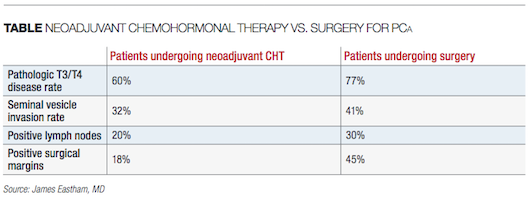Article
Neoadjuvant chemohormonal therapy efficacious for high-risk PCa
Author(s):
Neoadjuvant chemohormonal therapy warrants consideration in the management of men undergoing radical prostatectomy for clinically localized high-risk prostate cancer, said James Eastham, MD, at the American Society of Clinical Oncology annual meeting in Chicago.
Neoadjuvant chemohormonal therapy (CHT) warrants consideration in the management of men undergoing radical prostatectomy for clinically localized high-risk prostate cancer, said James Eastham, MD, at the American Society of Clinical Oncology annual meeting in Chicago.
His statement was based on the results of a phase III randomized controlled trial (CALGB 90203) showing that pathologic features at surgery and biochemical progression-free survival (bPFS) were significantly better in men who received presurgical treatment with docetaxel (Taxotere) plus an LHRH agonist than in those who were managed with surgery alone.
After a median follow-up of 6 years (range, 0 to 12 years), overall survival (OS) was also better in men who received neoadjuvant CHT compared to those who underwent surgery alone, although the difference between groups only approached statistical significance (p=.06).
“Adding neoadjuvant ADT to RP has not improved outcomes for men with clinically localized high-risk prostate cancer compared to RP alone. The results of our study show that neoadjuvant CHT at least has a benefit for delaying bPFS, and we expect that it will be found to provide an overall survival benefit as follow-up continues,” said Dr. Eastham, CALGB 90203 study chair and chief of the urology service and Peter T. Scardino Chair in Oncology, Memorial Sloan Kettering Cancer Center, New York.

“We did not have any deaths related to the neoadjuvant CHT in our study, although docetaxel was associated with some grade 3/4 toxicities,” Dr. Eastham told Urology Times.
Read: PSA adjustments are required in men taking 5-ARIs
“Based on our findings, I believe that the potential benefits and risks of neoadjuvant CHT should be included in the discussion of management options with men who have clinically localized high-risk prostate cancer,” he added.
The study, which started in December 2006, enrolled men with clinical stage T1-3a prostate cancer, PSA ≤100 ng/mL, no radiographic evidence of metastasis, and a Kattan preoperative nomogram probability of <60% bPFS at 5 years after RP or biopsy Gleason score 8-10. Men were stratified prior to randomization based on nomogram prediction for bPFS and use of ADT.
A total of 788 men were randomized 1:1 to surgery alone or to receive six cycles of docetaxel, 75 g/m2 IV every 21 days with 18 to 24 weeks of LHRH agonist treatment (leuprolide or goserelin) prior to surgical intervention (staging pelvic lymph node dissection and radical prostatectomy) or surgical intervention alone.
The two study groups were similar at baseline in their median age, clinical stage and biopsy Gleason score distribution, median PSA distribution, nomogram risk group, and prior androgen deprivation therapy use.
Next: 4/5 endpoints favor neoadjuvant CHT group4/5 endpoints favor neoadjuvant CHT group
The analysis of between-group differences in pathologic features was an exploratory analysis using reports from each treating center; results from central review are pending. In four out of five endpoints, there was a statistically significant (p≤.05) between-group difference favoring the men who received neoadjuvant CHT.
Variables for which the neoadjuvant CHT and control groups were compared included: pathologic T3/T4 disease (60% vs. 77%, respectively), seminal vesicle invasion (32% vs. 41%, respectively), positive lymph nodes (20% vs. 30%, respectively), and positive surgical margins (18% vs. 45%, respectively). Gleason grade group distribution did not differ significantly between study groups.
Read: Prostate cancer agent evaluated by PSA progression status
Neoadjuvant CHT was associated with a 34% improvement in overall bPFS (p=.02). There was also a suggestion of a survival benefit with neoadjuvant CHT.
“The 95% confidence interval for OS was 0.42 to 1.03, but there has been a steadily growing separation between groups over time, and the difference between groups is expected to achieve statistical significance in the next analysis,” Dr. Eastham told Urology Times.
Several of Dr. Eastham’s study co-authors have one or more disclosures related to pharmaceutical companies; for full disclosures, go to bit.ly/CALGB90203.














